英语语法一般过去时态介绍
- 格式:ppt
- 大小:705.50 KB
- 文档页数:10
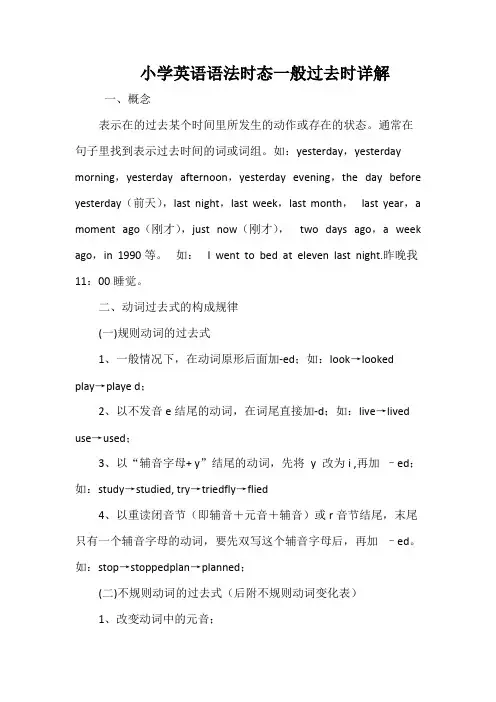
小学英语语法时态一般过去时详解一、概念表示在的过去某个时间里所发生的动作或存在的状态。
通常在句子里找到表示过去时间的词或词组。
如:yesterday,yesterday morning,yesterday afternoon,yesterday evening,the day before yesterday(前天),last night,last week,last month,last year,a moment ago(刚才),just now(刚才),two days ago,a week ago,in 1990等。
如:I went to bed at eleven last night.昨晚我11:00睡觉。
二、动词过去式的构成规律(一)规则动词的过去式1、一般情况下,在动词原形后面加-ed;如:look→looked play→playe d;2、以不发音e结尾的动词,在词尾直接加-d;如:live→lived use→used;3、以“辅音字母+ y”结尾的动词,先将y 改为i ,再加–ed;如:study→studied, try→triedfly→flied4、以重读闭音节(即辅音+元音+辅音)或r音节结尾,末尾只有一个辅音字母的动词,要先双写这个辅音字母后,再加–ed。
如:stop→stoppedplan→planned;(二)不规则动词的过去式(后附不规则动词变化表)1、改变动词中的元音;begin→began drink→drank come→came eat→ate grow→grew run→ran know→knew win→wonspeak→spoketake→took write→wrote get→got2、变词尾的–d 为–t ;build→built lend→lent send→sent spend→spent bend→bent3、与动词原形一样;cut→cut put→put cost→cost hurt→hurt shut→shut4、变-ay 为-aid (少数动词);say→said pay→paid lay→laid5、采用不同词根;sell→sold teach→taught buy→bought6、其他。
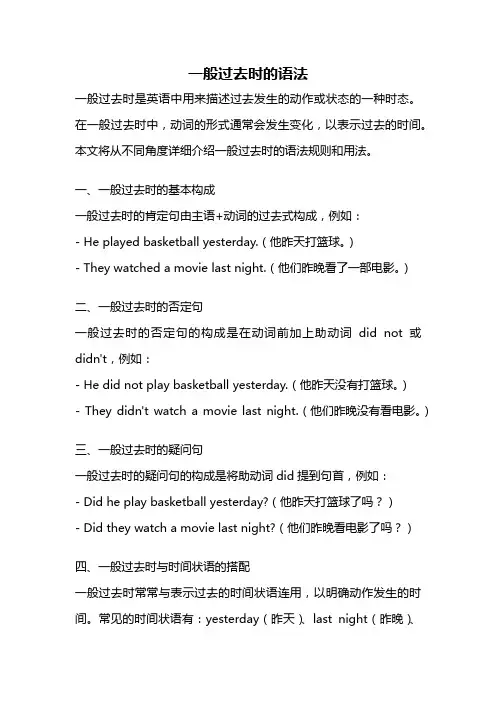
一般过去时的语法一般过去时是英语中用来描述过去发生的动作或状态的一种时态。
在一般过去时中,动词的形式通常会发生变化,以表示过去的时间。
本文将从不同角度详细介绍一般过去时的语法规则和用法。
一、一般过去时的基本构成一般过去时的肯定句由主语+动词的过去式构成,例如:- He played basketball yesterday.(他昨天打篮球。
)- They watched a movie last night.(他们昨晚看了一部电影。
)二、一般过去时的否定句一般过去时的否定句的构成是在动词前加上助动词did not或didn't,例如:- He did not play basketball yesterday.(他昨天没有打篮球。
)- They didn't watch a movie last night.(他们昨晚没有看电影。
)三、一般过去时的疑问句一般过去时的疑问句的构成是将助动词did提到句首,例如:- Did he play basketball yesterday?(他昨天打篮球了吗?)- Did they watch a movie last night?(他们昨晚看电影了吗?)四、一般过去时与时间状语的搭配一般过去时常常与表示过去的时间状语连用,以明确动作发生的时间。
常见的时间状语有:yesterday(昨天)、last night(昨晚)、last week(上周)、in 2010(在2010年)等等。
五、一般过去时的用法1. 表示过去发生的动作或状态She lived in New York for five years.(她在纽约住了五年。
)2. 表示过去经常或反复发生的动作He often went swimming when he was young.(他年轻时经常去游泳。
)3. 表示过去的习惯或常态She always cooked dinner for her family.(她过去总是为家人做晚饭。
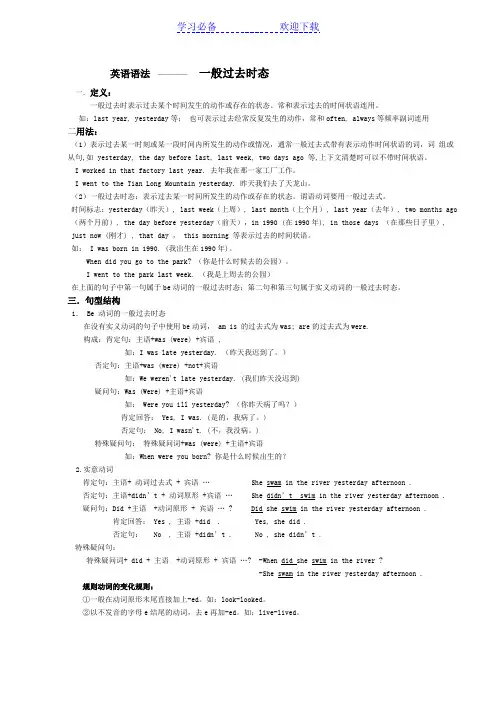
英语语法————一般过去时态一.定义:一般过去时表示过去某个时间发生的动作或存在的状态。
常和表示过去的时间状语连用。
如:last year, yesterday等;也可表示过去经常反复发生的动作,常和often, always等频率副词连用二用法:(1)表示过去某一时刻或某一段时间内所发生的动作或情况,通常一般过去式带有表示动作时间状语的词,词组或从句,如 yesterday, the day before last, last week, two days ago 等,上下文清楚时可以不带时间状语。
I worked in that factory last year. 去年我在那一家工厂工作。
I went to the Tian Long Mountain yesterday. 昨天我们去了天龙山。
(2)一般过去时态:表示过去某一时间所发生的动作或存在的状态。
谓语动词要用一般过去式。
时间标志:yesterday(昨天), last week(上周), last month(上个月), last year(去年), two months ago (两个月前), the day before yesterday(前天),in 1990 (在1990年), in those days (在那些日子里), just now (刚才) , that day , this morning 等表示过去的时间状语。
如: I was born in 1990. (我出生在1990年)。
When did you go to the park? (你是什么时候去的公园)。
I went to the park last week. (我是上周去的公园)在上面的句子中第一句属于be动词的一般过去时态;第二句和第三句属于实义动词的一般过去时态。
三.句型结构1. Be 动词的一般过去时态在没有实义动词的句子中使用be动词, am is 的过去式为was; are的过去式为were.构成:肯定句:主语+was (were) +宾语 ,如:I was late yesterday. (昨天我迟到了。
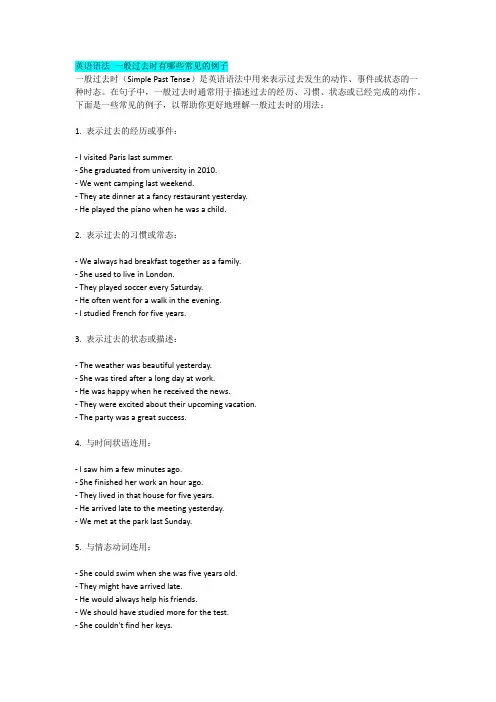
英语语法一般过去时有哪些常见的例子一般过去时(Simple Past Tense)是英语语法中用来表示过去发生的动作、事件或状态的一种时态。
在句子中,一般过去时通常用于描述过去的经历、习惯、状态或已经完成的动作。
下面是一些常见的例子,以帮助你更好地理解一般过去时的用法:1. 表示过去的经历或事件:- I visited Paris last summer.- She graduated from university in 2010.- We went camping last weekend.- They ate dinner at a fancy restaurant yesterday.- He played the piano when he was a child.2. 表示过去的习惯或常态:- We always had breakfast together as a family.- She used to live in London.- They played soccer every Saturday.- He often went for a walk in the evening.- I studied French for five years.3. 表示过去的状态或描述:- The weather was beautiful yesterday.- She was tired after a long day at work.- He was happy when he received the news.- They were excited about their upcoming vacation.- The party was a great success.4. 与时间状语连用:- I saw him a few minutes ago.- She finished her work an hour ago.- They lived in that house for five years.- He arrived late to the meeting yesterday.- We met at the park last Sunday.5. 与情态动词连用:- She could swim when she was five years old.- They might have arrived late.- He would always help his friends.- We should have studied more for the test.- She couldn't find her keys.6. 否定句和疑问句:- I did not go to the party.- Did she see the movie?- They didn't finish their homework on time.- Was he at home yesterday?- Did you have a good time at the concert?7. 连词连用:- When I was a child, I loved playing outside.- While they were cooking, I set the table.- As I walked down the street, I saw an old friend.这些例子涵盖了一般过去时在不同语境下的应用。
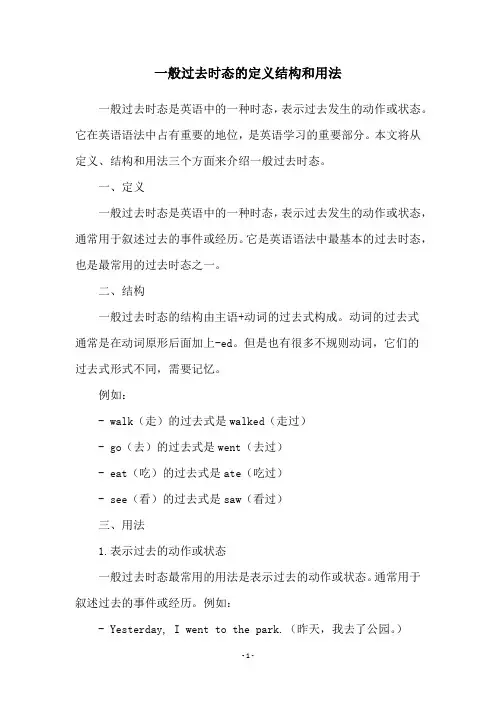
一般过去时态的定义结构和用法一般过去时态是英语中的一种时态,表示过去发生的动作或状态。
它在英语语法中占有重要的地位,是英语学习的重要部分。
本文将从定义、结构和用法三个方面来介绍一般过去时态。
一、定义一般过去时态是英语中的一种时态,表示过去发生的动作或状态,通常用于叙述过去的事件或经历。
它是英语语法中最基本的过去时态,也是最常用的过去时态之一。
二、结构一般过去时态的结构由主语+动词的过去式构成。
动词的过去式通常是在动词原形后面加上-ed。
但是也有很多不规则动词,它们的过去式形式不同,需要记忆。
例如:- walk(走)的过去式是walked(走过)- go(去)的过去式是went(去过)- eat(吃)的过去式是ate(吃过)- see(看)的过去式是saw(看过)三、用法1.表示过去的动作或状态一般过去时态最常用的用法是表示过去的动作或状态。
通常用于叙述过去的事件或经历。
例如:- Yesterday, I went to the park.(昨天,我去了公园。
)- I studied English for three hours yesterday.(昨天我学了三个小时的英语。
)- They lived in New York for ten years.(他们在纽约住了十年。
)2.表示过去的习惯或经常性动作一般过去时态还可以用来表示过去的习惯或经常性动作。
例如: - When I was young, I played basketball every day.(我年轻的时候,每天都打篮球。
)- My grandfather smoked a pipe every evening.(我爷爷每天晚上都抽烟斗。
)3.表示过去的真实条件一般过去时态还可以用来表示过去的真实条件。
例如:- If I had time, I would visit you.(如果我有时间,我会去看你。
)- If it rained, we stayed inside.(如果下雨了,我们就呆在屋子里。
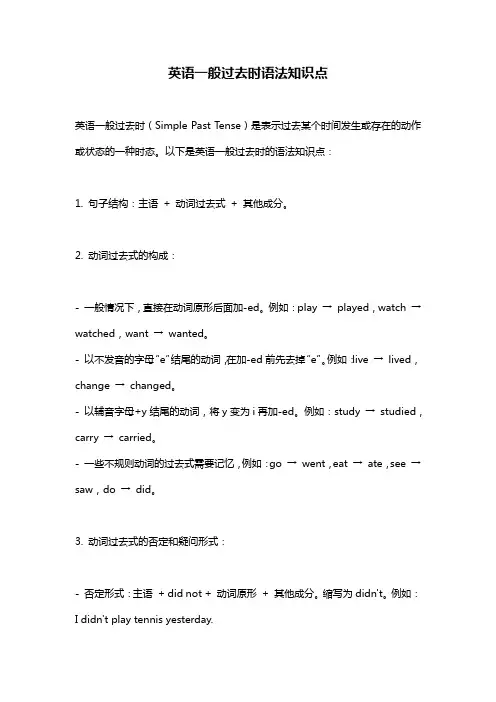
英语一般过去时语法知识点英语一般过去时(Simple Past Tense)是表示过去某个时间发生或存在的动作或状态的一种时态。
以下是英语一般过去时的语法知识点:1. 句子结构:主语+ 动词过去式+ 其他成分。
2. 动词过去式的构成:- 一般情况下,直接在动词原形后面加-ed。
例如:play →played,watch →watched,want →wanted。
- 以不发音的字母“e”结尾的动词,在加-ed前先去掉“e”。
例如:live →lived,change →changed。
- 以辅音字母+y结尾的动词,将y变为i再加-ed。
例如:study →studied,carry →carried。
- 一些不规则动词的过去式需要记忆,例如:go →went,eat →ate,see →saw,do →did。
3. 动词过去式的否定和疑问形式:- 否定形式:主语+ did not + 动词原形+ 其他成分。
缩写为didn't。
例如:I didn't play tennis yesterday.- 疑问形式:Did + 主语+ 动词原形+ 其他成分例如:Did you watch the movie last night?4. 一般过去时的时间状语:昨天(yesterday)、上个月(last month)、去年(last year)等表示过去某个具体时间的时间状语。
5. 一般过去时的用法:- 表示过去某个具体时间发生的动作或状态。
例如:I went to the beach yesterday.- 表示过去一段时间内发生的动作或状态。
例如:I lived in London for two years.- 表示过去习惯性的动作或状态。
例如:When I was a child, I always played with my friends.以上就是英语一般过去时的语法知识点。
记得多加练习,熟练掌握一般过去时的用法。
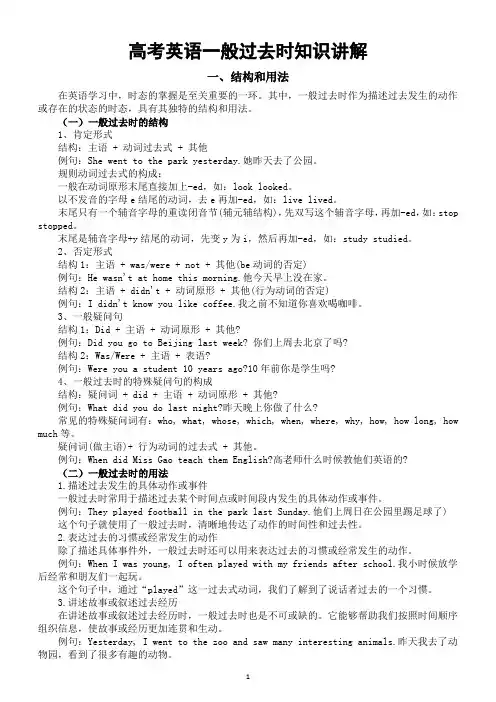
高考英语一般过去时知识讲解一、结构和用法在英语学习中,时态的掌握是至关重要的一环。
其中,一般过去时作为描述过去发生的动作或存在的状态的时态,具有其独特的结构和用法。
(一)一般过去时的结构1、肯定形式结构:主语 + 动词过去式 + 其他例句:She went to the park yesterday.她昨天去了公园。
规则动词过去式的构成:一般在动词原形末尾直接加上-ed,如:look looked。
以不发音的字母e结尾的动词,去e再加-ed,如:live lived。
末尾只有一个辅音字母的重读闭音节(辅元辅结构),先双写这个辅音字母,再加-ed,如:stop stopped。
末尾是辅音字母+y结尾的动词,先变y为i,然后再加-ed,如:study studied。
2、否定形式结构1:主语 + was/were + not + 其他(be动词的否定)例句:He wasn't at home this morning.他今天早上没在家。
结构2:主语 + didn't + 动词原形 + 其他(行为动词的否定)例句:I didn't know you like coffee.我之前不知道你喜欢喝咖啡。
3、一般疑问句结构1:Did + 主语 + 动词原形 + 其他?例句:Did you go to Beijing last week? 你们上周去北京了吗?结构2:Was/Were + 主语 + 表语?例句:Were you a student 10 years ago?10年前你是学生吗?4、一般过去时的特殊疑问句的构成结构:疑问词 + did + 主语 + 动词原形 + 其他?例句:What did you do last night?昨天晚上你做了什么?常见的特殊疑问词有:who, what, whose, which, when, where, why, how, how long, how much等。
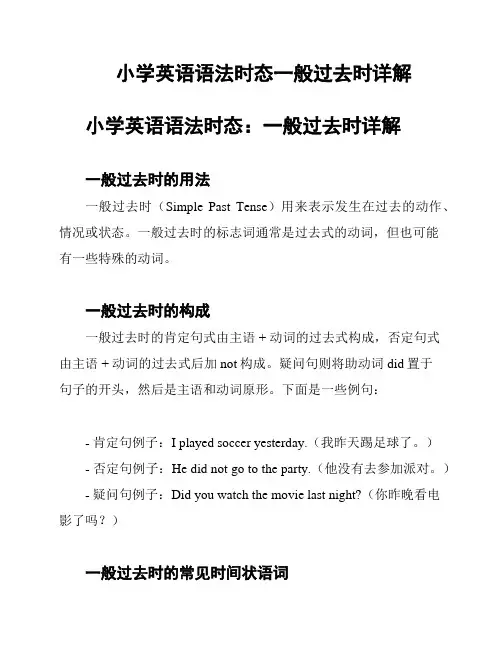
小学英语语法时态一般过去时详解小学英语语法时态:一般过去时详解一般过去时的用法一般过去时(Simple Past Tense)用来表示发生在过去的动作、情况或状态。
一般过去时的标志词通常是过去式的动词,但也可能有一些特殊的动词。
一般过去时的构成一般过去时的肯定句式由主语 + 动词的过去式构成,否定句式由主语 + 动词的过去式后加not构成。
疑问句则将助动词did置于句子的开头,然后是主语和动词原形。
下面是一些例句:- 肯定句例子:I played soccer yesterday.(我昨天踢足球了。
)- 否定句例子:He did not go to the party.(他没有去参加派对。
)- 疑问句例子:Did you watch the movie last night?(你昨晚看电影了吗?)一般过去时的常见时间状语词一般过去时通常会和一些时间状语词一起使用,以明确动作发生的具体时间。
以下是一些常见的时间状语词:- yesterday(昨天)- last week(上周)- two days ago(两天前)- in 1998(在1998年)一般过去时的特殊用法一般过去时有一些特殊的用法需要注意:1. 表示过去经常性的动作或惯。
例如:When I was young, I played soccer every day.(当我年轻时,我每天都踢足球。
)2. 表示过去事实或真理。
例如:The earth revolved around the sun.(地球绕太阳转。
)总结一般过去时用来描述发生在过去的动作、情况或状态。
它的构成简单,使用过去式的动词作为标志词。
通过加入时间状语词,可以更明确地指出动作发生的具体时间。
同时,一般过去时还有一些特殊的用法,需要灵活运用。
>注意:本文内容仅供参考,具体使用时请根据实际情况和教材要求进行调整。
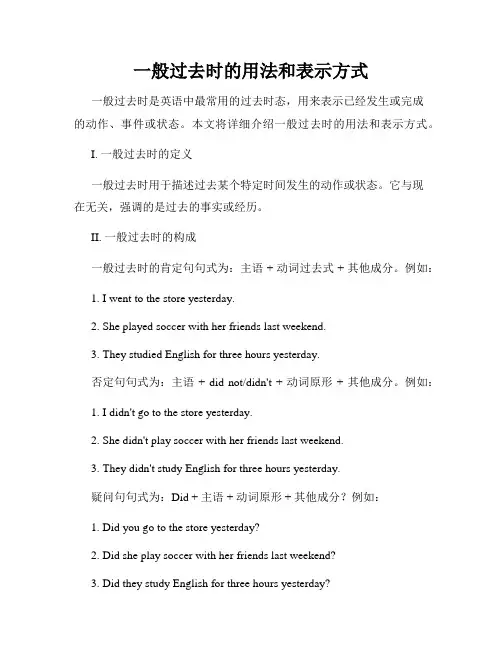
一般过去时的用法和表示方式一般过去时是英语中最常用的过去时态,用来表示已经发生或完成的动作、事件或状态。
本文将详细介绍一般过去时的用法和表示方式。
I. 一般过去时的定义一般过去时用于描述过去某个特定时间发生的动作或状态。
它与现在无关,强调的是过去的事实或经历。
II. 一般过去时的构成一般过去时的肯定句句式为:主语 + 动词过去式 + 其他成分。
例如:1. I went to the store yesterday.2. She played soccer with her friends last weekend.3. They studied English for three hours yesterday.否定句句式为:主语 + did not/didn't + 动词原形 + 其他成分。
例如:1. I didn't go to the store yesterday.2. She didn't play soccer with her friends last weekend.3. They didn't study English for three hours yesterday.疑问句句式为:Did + 主语 + 动词原形 + 其他成分?例如:1. Did you go to the store yesterday?2. Did she play soccer with her friends last weekend?3. Did they study English for three hours yesterday?III. 一般过去时的表示方式1. 定时或时间状语词一般过去时中常常与表示过去时间的词语或短语一起使用,如yesterday(昨天)、last night(昨晚)、in 1999(在1999年)等。
这些时间状语词能够帮助准确表达动作或事件发生的具体时间。

在高中英语学习中,了解和掌握一般过去时是非常重要的。
一般过去时用于描述过去发生的动作、状态或习惯。
本文将详细介绍一般过去时,以帮助学生更好地理解和运用这一时态。
一、一般过去时的用法:一般过去时用于以下情况:1. 过去发生的动作:表示在过去某个时间发生的动作或事件。
例句:I watched a movie last night.(昨晚我看了一部电影。
)2. 过去的状态:描述过去某一时刻的状态或条件。
例句:She was happy yesterday.(昨天她很开心。
)3. 过去的习惯:表示过去经常或习惯性发生的动作。
例句:They always went for a walk after dinner.(他们过去经常在晚饭后散步。
)二、一般过去时的构成:一般过去时的肯定句由主语加动词的过去式构成,否定句和疑问句需要使用助动词did。
1. 肯定句的构成:主语+ 动词过去式+ 其他成分例句:He played soccer with his friends yesterday.(昨天他和他的朋友们踢足球。
)2. 否定句的构成:主语+ did not + 动词原形+ 其他成分例句:She did not go to the party last night.(她昨晚没有去参加派对。
)3. 疑问句的构成:Did + 主语+ 动词原形+ 其他成分?例句:Did you finish your homework?(你完成作业了吗?)三、一般过去时的常见例句:1. I visited my grandparents last summer vacation.(去年暑假我拜访了我的爷爷奶奶。
)2. He studied English for three hours yesterday.(昨天他学了三个小时的英语。
)3. We didn't see each other for a long time.(我们很长时间没有见面了。
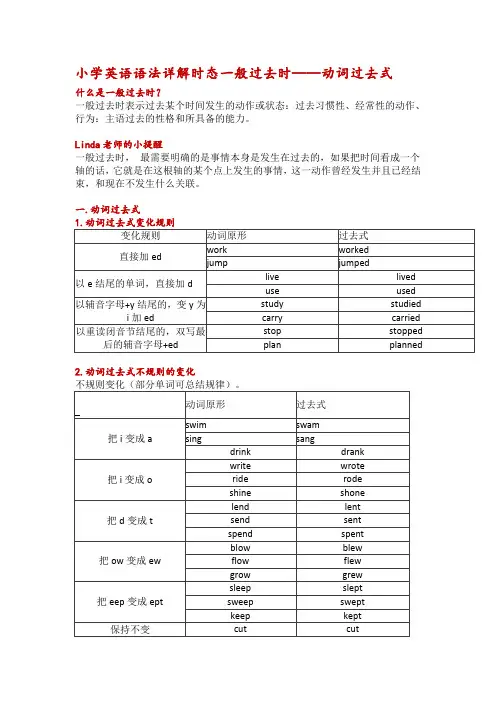
小学英语语法详解时态一般过去时——动词过去式什么是一般过去时?一般过去时表示过去某个时间发生的动作或状态:过去习惯性、经常性的动作、行为:主语过去的性格和所具备的能力。
Linda老师的小提醒一般过去时,最需要明确的是事情本身是发生在过去的,如果把时间看成一个轴的话,它就是在这根轴的某个点上发生的事情,这一动作曾经发生并且已经结束,和现在不发生什么关联。
一.动词过去式2.动词过去式不规则的变化Linda老师的小提醒★大部分过去式还是需要去记忆的:be动词的过去式一was(am,is的过去式). were(are的过去式)。
一些实义动词的过去式,dig→ dug,run→ ran,eat→ ate,fall→ fell,lie→ lay等。
★部分动词的过去式两种都是可以的,比如:lean→ leaned/leant;dream→ dreamt/dreamed;bet→ bet/betted等。
小学英语语法详解时态一般过去时——一般过去时的句式变化二.一般过去时的句式变化1.陈述句:主语+动词过去式+其他I saw the rianbow yesterday.我昨天看到了彩虹。
They went to he park last Sunday.上周日他们去了公园。
Ben got up at six this morning.本今天早上是六点起床的。
2.一般疑问句1)将be动词提到句首陈述句:It was an egg yesterday.它昨天还是一个蛋。
一般疑问句:Was it an egg yesterday?它昨天还是一个蛋吗?陈述句:They were at school just now.他们刚才还在学校。
一般疑问句:Were they at school just now?他们刚才还在学校吗?Linda老师的小提醒主语是第一人称和第二人称的句子,其过去时变化时,要注意be动词的变化。
一般疑问句:Were you at home last night?你昨天晚上在家吗?肯定回答:Yes,I was.否定回答:No,I wasn't.2)用助动词did陈述句:I did my homework at school,我在学校做了作业。
英语语法系列_一般过去式介绍一般过去时是表示过去发生的动作、状态或事件的时态。
在英语中,过去时态的构成和用法比较简单,但也有一些特殊情况需要注意。
下面是一系列详细介绍一般过去时的重要知识点。
1.构成一般过去时的句子构成由主语+动词过去式+其他部分组成。
例如:I played football yesterday.(我昨天踢了足球。
)He went to the movies last night.(他昨晚去看电影了。
)2.动词过去式的规则变化大多数动词过去式的构成是在动词原形后加上-ed。
例如:want → wanted,study → studied。
以辅音字母+y结尾的动词,将y改为i,再加-ed。
例如:carry → carried,study → studied。
以一个辅音字母结尾的重读闭音节动词,双写结尾的辅音字母再加-ed。
例如:stop → stopped,plan → planned。
不规则动词的过去式需要记忆。
例如:go → went,have → had。
3.过去时间状语的使用在过去时态中,常常和表示过去的时间状语连用,以明确动作的发生时间。
例如:yesterday(昨天),last week(上周),in 1990(在1990年)。
4.一般过去时的用法4.1表示过去的一些时间点的动作或事件。
例如:I visited Paris last month.(上个月我去了巴黎。
)They went to the park yesterday.(他们昨天去了公园。
)4.2表示过去经常发生的动作或状态。
例如:We always walked to school when we were children.(我们小时候经常走路去上学。
)She often cooked dinner for her family.(她经常给家人做晚饭。
)4.3表示过去习惯性的动作或状态。
例如:He used to live in London.(他过去住在伦敦。
初中英语语法一般过去时态介绍一般过去时态表示在过去发生的事情,其时间状语一般是表示在过去,这一点是其典型的特征。
下面我们从几个方面来探讨这种时态。
【No. 1】一般过去式的构成a.规则动词过去式的变化可速记为\"直\"、\"去\"、\"双\"、\"改\"四字诀。
①一般情况下在动词原形后直接加-ed。
如:wanted,played。
②以不发音的字母e结尾的动词,去掉e再加-ed。
如:hoped,lived。
③重读闭音节单词需双写最后一个辅音字母再加-ed。
如:stopped。
④以辅音字母+y结尾的动词变y为i,再加-ed。
如:studied,worried。
规则动词过去式的读音也有规律可循。
请记住:清后[t],元浊[d],[t] [d]之后读[Id]。
①清辅音[p] [k] [f] [s] [F] [tF]等后,ed要读[t]。
如:worked,finished。
②元音或浊辅音[b] [g] [v] [z] [m]等后,ed要读[d]。
如:lived,called。
③[t]或[d]后,ed读[Id]。
如:started,needed。
b.不规则动词变化,要逐一熟记。
be动词过去式有两种形式,主语是第一、三人称单数形式使用was,其他人称用were。
【No. 2】一般过去时的形式a. be动词过去式的句式。
否定句是在was/were后面加not,was not (wasn\'t)/were not (weren\'t)。
一般疑问句是把was / were提前并放到句首,要求首字母要大写。
b.实义动词过去式的句式。
①肯定式:主语+动词过去式+其它。
如:They had a good time yesterday.②否定式:主语+did not(didn\'t)+动词原形+其它。
如:They didn\'t watch TV last night.③一般疑问句:Did+主语+动词原形+其它?肯定回答:Yes,主语+did.否定回答:No,主语+didn\'t.如:Did they have a meeting two days ago? Yes,they did. / No,they didn\'t.④特殊疑问句:特殊疑问词+did+主语+动词原形+其它?如:What time did you finish your homework?【No. 3】一般过去时的用法a.主要用于过去某个时间发生的动作或状态。
初中英语语法八大时态之一般过去时
一般过去时
1.概念:过去某个时间里发生的动作或状态;过去习惯性、经常性的动作、行为。
2.基本结构:
①was/were;②行为动词过去式
否定形式:①was/were + not;②在行为动词前加didnt,同时还原行为动词。
一般疑问句:①was或were放于句首;②用助动词do的过去式did 提问,同时还原行为动词。
3.用法
1) 在确定的过去时间里所发生的动作或存在的状态。
时间状语有:yesterday,last week,an hour ago,the other day,in 1982等。
例如:Where did you go just now? 刚才你上哪儿去了?
2) 表示在过去一段时间内,经常性或习惯性的动作。
例如:When I was a child,I often played football in the street。
我是个孩子的时候,常在马路上踢足球。
Whenever the Browns went during their visit,they were given a warm welcome。
那时,布朗一家无论什么时候去,都受到热烈欢迎。
注意:used to + do:过去常常表示过去习惯性的动作或状态,但如今已不存在。
例如:Mother used not to be so forgetful。
老妈过去没那么健忘。
Scarf used to take a walk。
斯卡夫过去常常散步。
初中英语语法一般过去时一:构成1.Be动词的一般过去时态.在没有实义动词的句子中使用be动词,am is的过去式为was; are的过去式为were.构成:肯定句:主语+was (were) +表语如:I XXX.(昨天我迟到了。
)否定句:主语+was (were) +not+表语如:XXX.(我们昨天没迟到)【注意】:当句中含有系动词was,were时,可直接在其后加not构成否定句。
如:I was on the Interntwhen you called me.当你打电话给我时,我在上网。
→:I was not/wasn'tonthe Internt when you called me .当你打电话给我时,我不在上网。
疑问句:Was (Were) +主语+表语如:XXX?(你昨天病了吗?)肯定回答:Yes,I was.(是的,我病了。
)否定句:No,I wasn't.(不,我没病。
)特殊疑问句:特殊疑问词+was (were) +主语+表语如:When were you born?你是什么时候出生的?2.实义动词的普通曩昔时态肯定句要使用动词的过去式,否定句和疑问句要使用助动词do和does的过去式did.一定句为:主语+动词曩昔式+宾语如:I went home at nine o'clock XXX.(我今天九点钟回的家。
)否定句:主语+didn't +动词原形+宾语如:I XXX't go home XXX.(我今天没回家。
)疑问句:Did +主语+动词真相+宾语如:Did you go home yesterday?(你昨天回家了吗?)肯定回答:Yes,I did.(是的,我回了。
)否定回答:No,I XXX't.(不,我没回家。
)3.助动词和情态动词过去式如下:shall―should(将要)用于第一人称单数will―would(将要)用于所有人称can—could(能,会)may―might(可以)must―must (必须)have to―had to(不得不)助动词和情态动词的过去时态要使用他们的过去式,后面的动词还使用原形。
一般过去时态的定义结构和用法一般过去时态是英语语法中最基础的时态之一,它表示发生在过去某个时间的动作或状态。
本文将从定义、结构和用法三个方面来详细介绍一般过去时态。
一、定义一般过去时态用于描述已经完成的动作或状态,它与现在没有任何关系,是过去的事情。
例如:I went to the park yesterday.(昨天我去了公园。
)She studied English for three years.(她学习英语三年了。
)二、结构一般过去时态的结构比较简单,通常由动词的过去式来表示。
对于大多数动词,过去式是在词尾加上“-ed”,例如:walk → walked(走→走过)talk → talked(谈话→谈过)play → played(玩耍→玩过)但是也有一些动词的过去式是不规则的,需要进行记忆和学习,例如:go → went(去→去过)eat → ate(吃→吃过)see → saw(看→看过)三、用法1. 表示过去的动作或状态一般过去时态最常见的用法是描述过去发生的动作或状态,例如: I watched a movie last night.(昨晚我看了一部电影。
)He was very happy when he got the news.(当他得到那个消息时他非常高兴。
)2. 表示过去的习惯或经常性动作一般过去时态也可以表示过去的习惯或经常性动作,通常需要用副词或时间状语来说明。
例如:When I was a child, I often played with my friends after school.(当我还是个孩子的时候,放学后我经常和我的朋友们玩。
) She always drank coffee in the morning.(她总是在早上喝咖啡。
)3. 表示过去的条件语句一般过去时态也可以用于表示过去的条件语句,通常需要用“if”引导。
例如:If I had known the truth, I would have done things differently.(如果我当时知道真相,我会做出不同的选择。
一般过去时的语法规则 (grammar)一般过去时是英语中用来描述过去发生的动作、事件或状态的一种时态。
在使用一般过去时时,我们需要遵守以下语法规则:- 动词过去式的构成:动词过去式通常是将动词原形加上-ed 结尾。
例如,work → worked;play → played。
然而,一些动词的过去式形式是不规则的,需要进行记忆,例如,go → went;eat → ate。
动词过去式的构成:动词过去式通常是将动词原形加上-ed结尾。
例如,work → worked;play → played。
然而,一些动词的过去式形式是不规则的,需要进行记忆,例如,go → went;eat → ate。
- 肯定句的结构:在肯定句中,我们使用主语+动词过去式+其他补充成分的结构。
例如,I worked hard yesterday.肯定句的结构:在肯定句中,我们使用主语+动词过去式+其他补充成分的结构。
例如,I worked hard yesterday.- 否定句的结构:在否定句中,我们使用主语+did not/didn't+动词原形+其他补充成分的结构。
例如,I didn't go to the party lastnight.否定句的结构:在否定句中,我们使用主语+did not/didn't+动词原形+其他补充成分的结构。
例如,I didn't go to the party last night.- 疑问句的结构:在疑问句中,我们使用Did+主语+动词原形+其他补充成分的结构。
例如,Did you finish your homework?疑问句的结构:在疑问句中,我们使用Did+主语+动词原形+其他补充成分的结构。
例如,Did you finish your homework?- 时间状语的使用:一般过去时常与表示过去时间的状语词连用,以明确动作、事件或状态发生的时间。